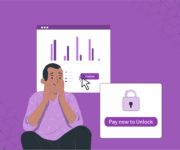In recent years, India’s digital lending industry has significantly boomed. Statista reports that it’s one of the “fastest-growing FinTech segments.” For instance, it grew from USD 9 billion to USD 270 billion in the latest decade (2012-2022).
According to many analysts, it’s all thanks to strategies offered by the RBI Innovation Hub (RBIH). Recently, they unveiled a new initiative called the Unified Lending Interface (ULI). Designed to help enhance credit access for everyone, it particularly focuses on assisting MSMEs with their lending strategies.
In this blog post, we’ll learn everything about ULI, its features, and recent developments.
What Is Unified Lending Interface (ULI)?
Did you know that 40% of MSMEs worldwide have an unmet financial need? That’s well over USD five trillion every year.
In India, this sector contributed 30.1% of GDP in 2022 and 2023. Even then, they face issues with the high cost of credit, formalisation of timely credit facilities, and credit access.
As mentioned, the ULI by RBIH aims to change India’s digital lending process, especially in the MSME sector. According to ResearchGate, ULI integrates diverse sets of data sources with alternative data and machine learning.
As a result, this initiative can enhance the efficiency and accuracy of credit evaluations, making credit access efficient and easier.
Features of Unified Lending Interface (ULI) That Make Digital Lending Smoother
The key features of ULI that will make the digital lending process smoother include the following:
- Data access is based on consent, allowing lenders to get non-financial and critical financial information about borrowers. Examples include satellite data, property search services, digitised state land records, and more.
- The use of standardised APIs enables a unique ‘plug-and-play’ approach, allowing lenders to easily integrate with ULI without extensive technical adjustments.
- ULI uses data aggregators (government databases, credit bureaus, etc.) to offer a holistic view of a borrower’s financial condition.
- Live data sources include GSTN data, land record systems, house and property search data, transliteration, etc.
All these can eventually reduce financial fraud and turnaround time for credit access. Companies like Finezza are on the front lines, empowering lenders to deal with such cases.
They’ve created a Loan Organisation and Loan Management Software. It assists lenders in tracking and managing credit applications, assessing digital lending risks, and more.
Did RBI Approach Data Aggregators to Help Build ULI and Revolutionise Digital Lending?
The Economic Times recently highlighted that RBI is exploring collaboration with data-rich aggregators for a better digital lending experience in India.
IBM reports that the data aggregation process gathers raw data and summarises it for statistical analysis. Technically, data aggregators are organisations that collect customer information from unique sources, process the data, and repackage it for better use.
Rajesh Bansal, the CEO of RBIH, mentioned that ULI has already integrated with DigiLocker and GSTN. However, they needed to see the kind of data that could be unlocked to facilitate nano entrepreneur loans worth ₹2-5 lakhs.
Which Data Aggregators Did RBIH Tap for ULI?
RBIH has approached a few data-rich aggregators to build the ambitious ULI platform for digital lending:
- Namma Yatri
- Swiggy
- Zomato
- Rapido
- Amul
They’ve also explored a collaboration with Google Pay. This partnership will help gain insights and data derived from UPI transactions, warehouse deposit receipts, and more. Discussions are still ongoing with PM Gati Shakti, E-Vahaan, ONDC, and the Unified Geospatial Interface.
What Exactly Can ULI Do to Change Digital Lending?
RBI governor Shaktikanta Das elaborated on the functionality of ULI as a revolutionising digital lending initiative. Here are a few things he highlighted:
- The ULI platform offers frictionless credit and will be launched nationwide soon.
- It’ll reduce the time taken for appraisals, especially in rural areas and with smaller borrowers.
- With this, lenders can let go of complicated technical integrations.
Like UPI, which transformed the payments and credit line ecosystem, ULI aims to supercharge the digital lending space in India.
What Does RBIH Aim?
The RBIH aims to create a foundational framework of “credit-focused digital public infrastructure.” For this, they’ll need alternative data sources from public and private aggregators.
That’s why they’ve reached out to the companies mentioned above to unlock financial data. It might help consolidate the digital footprint and economic activity of a billion Indians in one database for a better digital lending experience.
They aim to keep ULI as a consent-based platform where RBIH doesn’t store any data. Instead, it acts as a pipeline, helping lenders request information from data service providers for verification and better credit access.
How Can ULI Revolutionise Digital Lending?
Adding ULI to the India FinTech Stack is a great way to revolutionise digital lending. Here’s how:
Increased Financial Inclusion
Only 335.77 out of 1,000 adults had access to a loan account with commercial banks in 2023. ULI aims to simplify lending, making credit more accessible and obtaining loans easier.
Rural populations and MSMEs who lack formal credit histories will benefit from this. For instance, ULI makes capital accessible to 120 million farmers across the country.
Faster Loan Processing
Integration of a variety of data sources helps with quick credit evaluation, leading to better loan approval timeframes. With this efficiency, many borrowers can get faster capital for their business.
For example, 80 million dairy farmers can get seamless, paperless cattle financing. ULI will use milk collection data from cooperative societies for this type of digital lending.
Increased Transparency and Security
Online scammers have cheated victims out of ₹3 crores in rural parts of Kerala. Similarly, cyber crimes have gone up 1000% in Bengaluru rural districts.
It’s news like this that often limits rural borrowers from trusting lenders. Thankfully, the ULI promotes transparency by offering borrowers clarity on hidden fees, complex loan terms, interest rates, and more. This platform also uses a standardised process that ensures secure data sharing, reducing the risk of fraud in digital lending.
How Can Finezza Enhance ULI’s Effectiveness in Changing Digital Lending Processes?
As a cloud-based analytics solution, Finezza helps lenders process credit evaluations faster and streamline the entire lending process. Reports suggest that this company generated USD 282,000 as of March 2023.
But how can the solution help play a pivotal role in enhancing the effectiveness and functionality of ULI? Here are a few ways that’ll be possible:
Seamless Integration With ULI Platform
Finezza offers secure APIs that facilitate easy integration with legacy systems and digital platforms. That means users can smoothly connect their operations to the ULI framework.
Unified Loan Management
It combines loan management and credit tracking in a single system. This unified approach complements the ULI’s streamlined credit processes. Therefore, lenders will have reduced data silos and improved accessibility through real-time data.
Enhanced Data Analytics
The use of advanced analytics for assessing borrower creditworthiness aligns with ULI’s goal. For instance, Finezza analyses financial transactions and relevant data sources similar to ULI’s comprehensive data integration through aggregators. This can make credit risk assessments easier and more effective.
Final Note
RBIH developed a Unified Lending Interface (ULI), leading to a partnership with data aggregators. Companies like Rapido, Swiggy, Namma Yatri, and Amul have joined hands to share data and speed up loan approvals for better digital lending.
Their goal? To make lending more accessible for farmers, small businesses, and MSMEs.
ULI integrates diverse data sources, employs advanced analytics, streamlines loan application processes, enhances credit access, and more. This consent-based data-sharing model is a user-friendly approach to building borrower and lender trust through transparency.
Platforms like Finezza can help such initiatives come to fruition, as it offers:
- Loan Origination Automation: Streamlines loan application and processing workflows.
- Credit Assessment: Provides advanced analytics for evaluating borrower creditworthiness.
- Data Integration: Integrates multiple data sources for a unified view of borrower profiles.
- Compliance Management: Ensures adherence to regulatory requirements through automated checks.
- Transparency Tools: Facilitates clear communication between borrowers and lenders.
- Scalability: Supports large-scale digital lending initiatives like ULI.
Contact Finezza to know more!




Leave a Reply